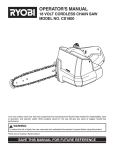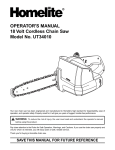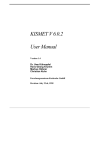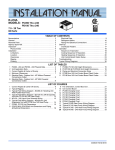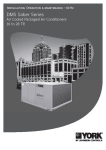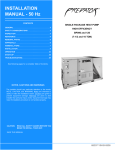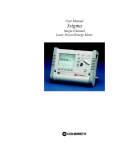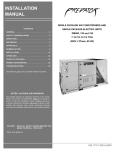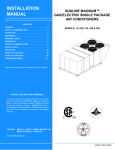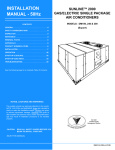Download DB Drive Speed Series Amplifier SPA SPA150.4 Product data
Transcript
Installation, Operation & Maintenance Manual - 50 Hz DMS Saber Series Air Cooled Packaged Air Conditioners 7.5, 8.5, 10.0 to 12.5 TR Installation, Operation & Maintenance Manual # 036-1009(0608) Page 2 TABLE OF CONTENTS GENERAL Safety considerations ................................................................ Inspection .................................................................................. Renewal parts ........................................................................... Product nomenclature ............................................................... 3 3 3 4 INSTALLATION Limitations ................................................................................ 4 Location .................................................................................... 5 Rigging and handling ................................................................ 5 Clearances ................................................................................ 5 Ductwork .................................................................................. 5 Fixed outdoor air intake damper................................................ 5 Condensate drain ...................................................................... 6 Compressors ............................................................................. 7 Filters ........................................................................................ 7 Service access .......................................................................... 7 Thermostat ............................................................................... 7 Power and control wiring .......................................................... 7 Optional electric heat ................................................................ 7 Phasing ..................................................................................... 8 Product data ............................................................................. 9 Dimensions and clearances (DMS 090, 100 & 120) .................. 10 Dimensions and clearances (DMS) 150...................................... 11 Drive and pulley data ................................................................ 12 Electrical data ........................................................................... 12 Fan performance data ............................................................... 13 Checking supply air cfm ............................................................ 14 SAFETY Terminology .............................................................................. Operational safety ..................................................................... Use and Operation .................................................................... Adherence to warnings ............................................................. Staff training ............................................................................. Use of the unit .......................................................................... Recommended safety practices ................................................ Applicable standards of EEC machinery directive ..................... 14 14 15 15 15 15 15 16 OPERATION Sound power ratings ................................................................ Volt free contact ....................................................................... Sequence of operations ............................................................ Cooling operation errors ........................................................... High pressure limit switch ......................................................... Low pressure limit switch .......................................................... Freezestat ................................................................................. Low ambient cooling ................................................................. Safety controls .......................................................................... Compressor protection ............................................................. Flash codes ............................................................................... Reset ......................................................................................... Electric heating sequence of operations ................................... Heating operation errors ........................................................... 17 17 17 17 18 18 18 18 18 18 18 19 19 19 START UP Restart check list ....................................................................... Operating instructions ............................................................... Post start check list ................................................................... Shut down ................................................................................. Belt drive blower ....................................................................... 19 19 19 19 19 TROUBLE SHOOTING Cooling trouble shooting guide ................................................. 20 Unit flash codes ........................................................................ 22 MAINTENANCE Every month .............................................................................. Every three months ................................................................... Every six months ....................................................................... Every twelve months ................................................................. 23 23 23 23 LIST OF FIGURES AND ILLUSTRATIONS Typical unit configuration .......................................................... 3 Product nomenclature ............................................................... 4 Typical rigging ........................................................................... 5 Fixed outdoor air intake damper ............................................... 6 Condensate drain ...................................................................... 6 Loading points ........................................................................... 6 Typical field wiring .................................................................... 8 Dimensions and clearances (DMS 090, 100 & 120) .................. 10 Dimensions and clearances (DMS) 150...................................... 11 Belt adjustment ......................................................................... 14 Unit nameplate .......................................................................... 14 Motor nameplate ...................................................................... 14 Warnings ................................................................................... 15 LIST OF TABLES Unit application data ................................................................. Loading Points ........................................................................... Control wire sizes ...................................................................... Minimum cfm limitation ............................................................ Product data .............................................................................. Drive and pulley data ................................................................ Electrical data ............................................................................ Fan performance data ............................................................... Applicable standards of EEC machinery directive ...................... Sound power levels (DMS Saber units) ..................................... Unit flash codes ........................................................................ 4 6 7 7 9 12 12 13 16 17 23 Installation, Operation & Maintenance Manual # 036-1009(0608) Page 3 GENERAL RENEWAL PARTS YORK Saber units are single package air conditioners equipped with optional factory installed electric heaters and designed for outdoor installation on a rooftop or steel structure. Refer to York USER’S MAINTENANCE and SERVICE INFORMATION MANUAL. It is strongly suggested that only genuine YORK Spare Parts are used to ensure efficient working of the unit and safety. The units are completely assembled on a rigid base frame. All piping, refrigerant charge, and electrical wiring is factory installed and tested. The units require electric power, duct connections and drain piping connections at the point of installation. The supplemental electric heaters have nickel-chrome elements and utilize single point power connection. SAFETY CONSIDERATIONS Due to system pressure, moving parts and electrical components, installation and servicing of air conditioning equipment can be hazardous. Only qualified, trained, service personnel should install, repair, maintain or service this equipment. Observe all precautions in the literature, on labels and tags accompanying the equipment whenever working on air conditioning equipment. Be sure to follow all other safety precautions that apply. CAUTION THIS PRODUCT MUST BE INSTALLED IN STRICT COMPLIANCE WITH THE ENCLOSED INSTALLATION INSTRUCTIONS AND ANY APPLICABLE LOCAL, STATE, AND NATIONAL CODES INCLUDING, BUT NOT LIMITED TO, BUILDING, ELECTRICAL, AND MECHANICAL CODES. WARNING IMPROPER INSTALLATION MAY CREATE A CONDITION WHERE THE OPERATION OF THE PRODUCT COULD CAUSE PERSONAL INJURY OR PROPERTY DAMAGE. Wear safety glasses and work gloves, and follow all safety codes. Use a quenching cloth and have a fire extinguisher available for all brazing operations. Installer should pay particular attention to the words : NOTE, CAUTION and WARNING. INSPECTION NOTES are intended to clarify or make the installation easier. As soon as a unit is received, it should be inspected for possible damage during transit. If damage is evident, the extent of the damage should be noted on the carrier’s freight bill. CAUTIONS are given to prevent equipment damage. WARNINGS are given to alert installer that personal injury and/ or equipment damage may result if installation procedure is not handled properly. TYPICAL UNIT CONFIGURATION Figure 1: Typical Unit Configuration Installation, Operation & Maintenance Manual # 036-1009(0608) Page 4 NOMENCLATURE INSTALLATION LIMITATIONS Read these instructions before continuing this appliance installation. This is an outdoor combination heating and cooling unit. The installer must assure that these instructions are made available to the consumer and with instructions to retain them for future reference. These units must be installed in accordance with the applicable national and local safety codes. (Refer to Unit Application Data table). If components are to be added to a unit to meet local codes, they are to be installed at the dealer’s and/or the customer’s expense. Size of unit for proposed installation should be based on heat loss/heat gain calculation. Table 1: Unit Application Data Installation, Operation & Maintenance Manual # 036-1009(0608) Page 5 LOCATION WARNING Use the following guidelines to select a suitable location for these units : BEFORE LIFTING A UNIT, MAKE SURE THAT ALL PANELS ARE IN PLACE AND THAT ITS WEIGHT IS DISTRIBUTED EQUALLY ON ALL CABLES SO IT WILL LIFT EVENLY. 1. Unit are designed for outdoor installation only. 2. Condenser coils must have an unlimited supply of air. 3. Where a choice of location is possible, position the unit on either north or east side of building. CLEARANCES 4. For ground level installation, use a level concrete slab. The length and width should be at least 6 inches greater than the unit base rails. Do not tie slab to the building foundation. 5. Roof structures must be able to support the weight of the unit and its options and/or accessories. Unit must be installed on a solid level roof curb. All units require certain clearances for proper operation and service. Installer must make provisions for adequate ventilation air in accordance with applicable provisions of the local building codes. Refer to Dimensions and Clearances. Refer Figures 7 & 8 for the clearances required for servicing, and proper unit operation. 6. Maintain level tolerance to 1/2 inch maximum across the entire length or width of the unit. RIGGING AND HANDLING Exercise care when moving the unit. Do not remove any packaging until the unit is near the place of installation. Rig the unit by attaching chain or cable slings to the round lifting holes provided in the base rails. Spreaders, whose length exceeds the largest dimension across the unit, MUST BE USED. Refer to Figure 2. Units may also be moved or lifted with a forklift, from the side only, provided that an accessory skid is used. LENGTH OF FORKS MUST BE A MINIMUM OF 70”. Refer to the Product Data Table 5 for unit weights. WARNING DO NOT PERMIT OVERHANGING STRUCTURES OR SHRUBS TO OBSTRUCT OUTDOOR AIR DISCHARGE OUTLET DUCTWORK A closed return duct system should be used. This should not preclude use of outdoor fresh air intake. The supply and return air duct connections at the unit should be made with flexible joints to minimize noise. The supply and return air duct systems should be designed for the CFM and static requirements of the job. They should NOT be sized to match the dimensions of the duct connections on the unit. WARNING WHEN FASTENING DUCTWORK TO SIDE DUCT FLANGES ON UNIT, INSERT SCREWS THROUGH DUCT FLANGES ONLY. DO NOT INSERT SCREWS THROUGH CASING. OUTDOOR DUCTWORK MUST BE INSULATED AND WATERPROOFED. Refer to Dimensions and Clearances Figure 8 for information concerning supply and return air duct openings. FIXED OUTDOOR AIR INTAKE DAMPER This damper is shipped inside the return air compartment. It is completely assembled and ready for installation. Refer to the Fixed Outdoor Damper Figure 3. Gasketing and mounting screws are provided in a parts bag. Adjusting the damper to the desired air flow may be done after installation by opening or closing dampers with handle. Figure 2: Typical Rigging Damper provides maximum of 25% fresh air when fully opened. Installation, Operation & Maintenance Manual # 036-1009(0608) Page 6 FIGURE 3 : FIXED OUTDOOR AIR DAMPER Figure 3: Fixed Outdoor Air Damper CONDENSATE DRAIN Plumbing must conform to local codes. Use a sealing compound on male pipe threads. Install a condensate drain line from the one-inch FPT female connection on the unit to an open drain. NOTE : The condensate drain operates in a negative pressure in the cabinet. The condensate drain line MUST be trapped to provide proper drainage. See Figure 4. FIGURE 5 : LOADING POINTS Pa Installation, Operation and Maintenance Manual : 036-1009(0606) Figure 4: Recommended Drain Piping Figure 5: Loading Points Installation, Operation & Maintenance Manual # 036-1009(0608) Page 7 COMPRESSORS Units are shipped with factory adjusted compressor mountings and ready for operation. CAUTION DO NOT LOOSEN COMPRESSOR MOUNTING BOLTS. REMOVE COMPRESSOR SHIPPING BRACKETS BEFORE START-UP. FILTERS Two inch filters can be supplied with each unit. Filters must always be installed ahead of the evaporator coil and must be kept clean or replaced with same size and type. Dirty filters will reduce the capacity of the unit and will result in frosted coils or safety shutdown. Minimum filter area and required sizes are shown in Product Data Table 4. SERVICE ACCESS The following removable panels provide access to all serviceable components : • • • • • Compressor compartment Electric Heat compartment Blower compartment Main control box Filter compartment Refer to the Dimensions and Clearances Figure 7 & 8 for location of these access panels. comply with local codes. Refer to the Dimensions and Clearances Figures 7 & 8 for installation location. If any of the wire supplied with the unit must be replaced, replacement wire must be of the type shown on the wiring diagram and the same minimum gauge as the replaced wire. Electrical line must be sized properly to carry the load. Use copper conductors only. Each unit must be wired with a separate branch circuit fed directly from the meter panel and properly fused. Emergency stop button should be field installed as per wiring diagram. The activator should be red in colour with a yellow outline background, and should be easily accessible. The device should be self latching type and contacts must be of positive opening operation, certified to EN60947 - 5 - 1. CAUTION WHEN CONNECTING ELECTRICAL POWER AND CONTROL WIRING TO THE UNIT, WATERPROOF TYPE CONNECTORS MUST BE USED SO THAT WATER OR MOISTURE CANNOT BE DRAWN INTO THE UNIT DURING NORMAL OPERATION. THE ABOVE WATERPROOFING CONDITIONS WILL ALSO APPLY WHEN INSTALLING A FIELD SUPPLIED DISCONNECT SWITCH. Refer to Typical Wiring Diagram, Figure 6 and to the appropriate unit wiring diagram for control circuit and power wiring information. THERMOSTAT The room thermostat should be located on an inside wall approximately 56 inches above the floor where it will not be subject to drafts, sun exposure or heat from electrical fixtures or appliances. Follow manufacturers instructions enclosed with thermostat for general installation procedure. A minimum of seven color coded insulated wires (#18 AWG) should be used to connect thermostat to unit. POWER AND CONTROL WIRING Field wiring to the unit must conform to provisions of the National Electrical Code and/or local ordinances. The unit must be electrically grounded in accordance with NEC and/or local codes. Table 2: Control Wire Sizes OPTIONAL ELECTRIC HEAT The factory installed heaters are wired for single point power supply. Power supply need only be brought into the single point terminal block and thermostat wiring to the low voltage terminal strip located in the upper portion of the unit control box. These heaters are located within the supply air chamber. Refer to Figuress 7 & 8 for access panel location. Fuses are supplied by the factory. Refer to Table 3 for minimum CFM limitations and to Table 5 for electrical data. Voltage tolerances, which must be maintained at the compressor terminals, during starting and running conditions, are indicated on the unit Rating Plate and the Unit Application Data table. A fused disconnect switch should be field provided based on the tabulated rating, with a short circuit capacity of 10K or more, for the unit. The switch must be separate from all other circuits. Wire entry at knockout openings require conduit fittings to Table 3: Minimum CFM Limitation Installation, Operation & Maintenance Manual # 036-1009(0608) Page 8 Figure 6: Typical Field Wiring Schematic PHASING YORK Saber units are properly phased at the factory. Check for proper compressor rotation. If the blower or compressors rotate in the wrong direction at start up, the electrical connection to the unit is mis-phased. Change the incoming line connection phasing to obtain proper rotation. CAUTION UNITS ARE PROPERLY PHASED AT THE FACTORY. DO NOT CHANGE THE INTERNAL WIRING TO MAKE THE BLOWER, CONDENSER FAN, OR COMPRESSOR ROTATE CORRECTLY. Installation, Operation & Maintenance Manual # 036-1009(0608) Page 9 PRODUCT DATA Table 4: Product Data Installation, Operation & Maintenance Manual # 036-1009(0608) Page 10 Clearances inches mm Front (Compressor Access) 36 914 Back (Blower Fan Access) 36 914 Left (Filter Access) 30 762 Right (Condenser Coil) 36 914 Above (Condenser Air Discharge) 72 1829 Figure 7: DIMENSIONAL DATA AND CLEARANCES DMS 090, 100 & 120 DIMENSIONS AND CLEARANCES DMS 090, 100 & 120 Installation, Operation & Maintenance Manual # 036-1009(0608) Page 11 Clearances inches mm Front (Control Panel & Compressor Access) 36 914 Left (Filter Access) 30 762 Right (Condenser Coil) 36 914 Above (Condenser Air Discharge) 72 1829 Figure 8: DIMENSIONAL DATA AND CLEARANCES DMS 150 DIMENSIONS AND CLEARANCES : DMS 150 Installation, Operation & Maintenance Manual # 036-1009(0608) Page 12 DRIVE AND PULLEY DATA Low Static Drive Set Pitch Diameter Model DMS Motor Pulley Bush Min Max Pitch Dia Bush Fan Pulley mm Centre Distance RPM Range mm Min Max mm Belt Size 90 VAR 108 A1 1210 x 24 mm 78 102 SPA-180 1 1610 x 25 mm 180 628 822 490 1404 100 VAR 108 A1 1210 x 24 mm 78 102 SPA-170 1 1610 x 25 mm 170 665 870 490 1388 120 VAR 108 A1 1210 x 28 mm 78 102 SPA-170 1 1610 x 25 mm 170 665 870 490 1388 150 VAR 108 A1 1210 x 28 mm 78 102 SPA-200 1 2012 x 25 mm 200 566 740 495 1446 Centre Distance Belt Size Standard Drive Set Pitch Diameter Model DMS Motor Pulley Bush Min Max Fan Pulley Pitch Dia Bush mm RPM Range mm Min Max mm 90 VAR 108 A1 1210 x 24 mm 78 102 SPA-125 1 1610 x 25 mm 125 905 1183 435 1207 100 VAR 108 A1 1210 x 24 mm 78 102 SPA-132 1 1610 x 25 mm 132 857 1120 435 1207 120 VAR 108 A1 1210 x 28 mm 78 102 SPA-132 1 1610 x 25 mm 132 854 1120 435 1207 150 VAR 108 A1 1210 x 28 mm 78 102 SPA-150 1 1610 x 25 mm 150 754 986 495 1357 High Static Drive Set Pitch Diameter Model DMS Motor Pulley Bush Min Max Fan Pulley Pitch Dia Bush mm Centre Distance RPM Range mm Min Max Belt Size mm 90 VAR 108 A1 1210 x 28 mm 78 102 SPA-112 1 1610 x 25 mm 112 1010 1321 435 1180 100 VAR 108 A1 1210 x 28 mm 78 102 SPA-106 1 1610 x 25 mm 106 1067 1395 435 1180 120 VAR 108 A1 1210 x 28 mm 78 102 SPA-106 1 1610 x 25 mm 106 1067 1395 435 1180 150 VAR 108 A1 1210 x 28 mm 78 102 SPA-118 1 1610 x 25 mm 118 958 1253 495 1317 Table 5: Drive Pulley Data ELECTRICAL DATA 380-415 V / 3 Ph / 50 Hz Power Supply Model Compressors RLA Each DMS 090 DMS 100 DMS 120 DMS 150 12.7 14.3 16.4 11.6 LRA Each 98.0 130.0 130.0 80.0 Condenser Fan Motors Supply Blower Motor Standard FLA FLA Each 2.3 2.3 2.3 4.3 Extended 3.6 3.6 4.9 6.6 4.9 4.9 6.6 8.6 Electric Heater Minimum Circuit Amperes Maximum Fuse Breaker Size kW Amperes Amperes Amperes - - 24.8 40 9.0 13.7 24.8 40 18.0 27.3 33.2 50 - - 27.1 40 9.0 13.7 27.1 40 18.0 27.3 33.2 50 - - 31.5 40 9.0 13.7 31.5 40 18.0 27.3 34.5 50 - - 41.0 60 18.0 27.3 41.0 60 36.0 54.7 65.6 90 Table 6: Electrical Data 2.2 1.5 2.2 12 / 12 12 / 12 15 / 15 100 120 150 4 3 Tab;e 7: Fan Performance Data 3 2.2 1.5 12 / 12 90 kW kW Size Optional DMS Standard Motor Fan Model 733 6000 2831 602 4500 2124 644 544 3750 1770 5000 2360 961 4800 2265 756 3500 1652 831 686 3000 1416 4000 1888 845 4000 1888 697 3000 1416 753 637 2500 1180 3400 1604 732 3250 1534 889 824 769 903 826 780 728 809 780 728 705 RPM 1.66 1.05 0.81 0.53 784 703 664 615 952 897 1.85 1.20 0.94 0.63 833 757 723 681 1.92 1054 1.21 0.89 846 967 1.24 0.65 900 855 807 883 855 807 792 RPM 965 924 885 949 924 885 876 RPM 964 916 2.03 1.33 1.07 0.75 879 810 778 743 2.06 1105 1.36 1015 1.03 0.76 989 962 958 RPM 1026 989 962 980 2.21 1.47 1.19 0.88 924 860 832 805 2.21 1158 1.51 1076 1.16 1025 0.85 1.54 1090 1.11 0.86 0.61 RPM 1071 2.37 1.62 1.34 1.02 966 908 885 864 2.39 1211 1.66 1132 1.27 1081 0.93 1045 1.70 1144 1.22 1083 0.94 1053 0.70 1036 1.11 0.94 1053 0.70 1036 RPM 955 935 921 2.53 1009 1.78 1.49 1.16 2.58 1262 1.80 1184 1.37 1137 1.02 1109 1.84 1197 1.31 1140 1.04 1118 0.81 1108 1.20 1131 1.04 1118 0.81 1108 RPM 986 976 2.69 1049 1.95 1003 1.66 1.32 2.77 1312 1.94 1234 1.47 1193 1.13 1173 1.97 1245 1.41 1198 1.14 1181 0.92 1177 1.30 1191 1.14 1181 0.92 1177 RPM - 2.88 1090 2.12 1048 1.83 1035 1.48 1029 2.95 2.05 1282 1.57 1249 1.25 1234 2.07 1293 1.51 1255 1.26 1242 1.05 1243 1.41 1249 1.26 1242 1.05 1243 RPM - - 3.07 1129 2.31 1093 2.01 1083 1.65 1082 - 2.15 1330 1.69 1304 1.37 1295 2.17 1.64 1311 1.39 1303 1.18 1307 1.54 1307 1.39 1303 1.18 1307 3.27 2.50 2.19 1.83 - 2.26 1.81 1.51 - 1.77 1.53 1.31 1.67 1.53 1.31 1.21 kW 2.00 [498] 1.09 1315 kW 1.80 [448] 0.96 1249 kW 1.60 [399] 0.84 1182 kW 1.40 [349] 0.73 1111 kW 1.20 [299] 0.62 1036 kW 1.00 [249] 1.01 1011 0.86 0.61 0.52 kW 0.80 [199] 1.39 1029 0.99 0.77 0.53 0.91 0.77 0.53 0.44 kW 0.60 [149] 0.86 0.66 0.46 0.78 0.66 0.46 0.37 kW 0.40 [100] 1.83 1004 1.11 0.78 0.54 1.13 0.75 0.55 0.37 0.67 0.55 0.37 0.30 kW [50] External Static Pressure in.wg. [Pa] Area shaded in grey represent upsize motors 637 2500 1180 697 612 2250 1062 3000 1416 RPM 0.20 L/s cfm Air Flow Rate Installation, Operation & Maintenance Manual # 036-1009(0608) Page 13 FAN PERFORMANCE & ADDITIONAL PRESSURE DROPS Installation, Operation & Maintenance Manual # 036-1009(0608) Page 14 CHECKING SUPPLY AIR CFM The RPM of the supply air blower will depend on the required CFM, the unit accessories or options and the static resistances of both the supply and the return air duct systems. With this information, the RPM for the supply air blower and the motor pulley adjustment (turns open) can be determined from the Fan Performance Data Tables. High speed drive accessories (containing a smaller blower pulley and a shorter belt) are available for applications requiring the supply air blower to produce higher CFM and/or higher static pressures. Refer to the Drive and Pulley Data Table 6. Figure 10: Unit Nameplate Sr.# Frame Figure 9: Belt Adjustment Note the following : 1. The supply air CFM must be within the limitations shown in the Unit Application Data Table 1. 2. Pulleys can be adjusted in half turn increments. 3. The tension on the belt should be adjusted as shown in the Belt Adjustment Figure 9. Start the supply air blower motor. Adjust the resistances in both the supply and the return air duct systems to balance the air distribution throughout the conditioned space. The job specifications may require that this balancing be done by someone other than the equipment installer. WARNING FAILURE TO PROPERLY ADJUST THE TOTAL SYSTEM AIR QUANTITY CAN RESULT IN EXTENSIVE BLOWER DAMAGE SAFETY This section of the IOM covers Safety Aspects applicable to the York DMS Saber Roof Top Air Conditioners. Adherence to the instructions detailed hereunder, will ensure the safety of the operators, prevent damage to the equipment and prevent accidents. IP ICL IC S 54 F 41 1 V ¨ 220 Y 380 Y 460 Y 380-415 kW 1.1 1.1 1.1 1.1 QSX90L6B02 Ph 3 3 3 3 Hz 60 60 60 50 rpm 1110 1110 1125 935 A 5.4 3.1 3.2 3.3 Cos Ɏ 0.72 0.72 0.67 0.69 Figure 11: Motor Nameplate TERMINOLOGY The internal section of the unit adjacent to moving parts and electrical parts or devices is considered as the ‘danger zone’. Prior to gaining access to these parts, it is necessary to acquire the proper tools to deactivate the safety devices. The operators are responsible for transport, installation, start up, service and maintenance, including cleaning and trouble shooting. OPERATIONAL SAFETY York DMS Saber Roof Top Packages Air Conditioners in conformance to the highest standards of operational as well as operator safety. Nevertheless, hazards may occur if the units are used for purposes other than the designed use(s), Units are operated by untrained staff and / or Units are not operated in conformance with general standards prevalent in the industry. Installation, Operation & Maintenance Manual # 036-1009(0608) Page 15 OPERATION AND USE OF THE UNIT IN CONFORMANCE WITH GENERAL STANDARDS AND PROVISIONS 3. Warnings against coming into contact with electrical parts. YORK DMS Saber Roof Top Packaged Air Conditioners are designed for and are able to cool, heat, filter air and operate in the fan mode. Any other use is considered not in conformity with general provisions. The manufacturer is not responsible for any resulting damages. All responsibility resulting from such non conformity rests with the user. In order to use the unit according to general provisions proper instructions for installation, exercise and transport must be observed. Installation and start up of the unit must satisfy the national codes and standards having legal validity in the country of use. The user is responsible for compliance with standards. Additionally, any type of work that may compromise safety should be avoided. Arbitrary transformations or modifications to the unit by the user or operator are not permitted and nullify the warranty of the manufacturer. The manufacturer will also not be responsible for any damages to the equipment, to property or to personnel. ADHERENCE OF THE USER / OPERATOR TO THE WARNINGS AND OTHER INSTRUCTIONS Clear signs are placed at appropriate locations on the unit showing : 1. Prohibition to repair or adjustments during motion. CURRENT All warnings and signs regarding the units must be absolutely observed. STAFF TRAINING The unit should be started up and serviced (routine and corrective maintenance) by authorized and trained staff only. This staff must be informed about possible hazards regarding : • • • • Electrical connections Piping connections Duct connections Start up These operations must be executed only by trained persons. who, on behalf of the user, attend to control and to perform extraordinary / ordinary maintenance of the unit. It is necessary to establish and to respect the responsibilities for control and maintenance to guaranty safety, without confusion. USE OF THE UNIT The unit must be started up only by means of proper safety devices. The installer is obliged to install the unit according to installation plans and conditions. Only authorized persons must operate the unit. DONT REPAIR OR ADJUST DURING THE MOVEMENT 2. Obligation to turn off the power before opening the access doors. The staff in charge is obliged to immediately inform the user of any changes that may compromise safety. For this reason it is necessary to inspect for eventual anomalies or damages at least once a week. The user or operator must never dismount and deactivate safety devices. If these have to be removed for maintenance, all safety devices must be reinstalled at their correct location once the maintenance is complete. For all operations of maintenance, the power source must be locked out. If it is necessary to undertake maintenance activities, the fan must be switched off, isolated and allowed to run down. RECOMMENDED SAFETY PRACTICES TURN OFF POWER BEFORE OPENING This publication explains the proper use and installation of equipment in order to warn operating and maintenance personnel of the commonly recognized dangers associated Installation, Operation & Maintenance Manual # 036-1009(0608) Page 16 with this equipment. In addition to following the manufacturer’s installation instructions, care must be taken to ensure compliance with federal, state and local rules, regulations, codes and standards. Installation, Operation & Maintenance Manual # 036-1009(0608) Page 17 OPERATION SOUND POWER RATINGS COOLING SEQUENCE OF OPERATION A sound power level is a measure of the total noise radiated by the machine in all directions. It is a property of the machine and is essentially independent of the measuring environment. Sound power levels are useful to equipment manufacturers, buyers, installers, and users for : • By setting the room thermostat fan switch to “ON” the supply air blower will operate continuously. • • Calculating the sound pressure level from a machine at a given distance in a given environment. • Comparing the noise output from different machines. • Setting specifications for the maximum permitted noise from a machine. • Comparing machines before and after modifications to reduce the noise. Sound power is measured in watts or picowatts, and sound power levels are traditionally given in decibels (dB re 1pW). Refer table 8 for sound power level of whole unit: Table 8: Sound Power Levels (DMS SABER UNITS) VOLT FREE CONTACT All Saber units are supplied with volt free contact, Refer to Electrical wiring schematic that are pasted inside the unit. CAUTION HOOK UP EMERGENCY SHUT - OFF BUTTON CONTINUOUS BLOWER INTERMITTENT BLOWER With the room thermostat fan switch set to “AUTO” and the system switch set to either the “AUTO” or “HEAT” settings, the blower is energized whenever a cooling or heating operation is requested. The blower is energized after any specified delay associated with the operation. When energized, the indoor blower has a minimum run time of 30 seconds. Additionally, the indoor blower has a delay of 10 seconds between operations. • NO OUTDOOR AIR OPTIONS When the thermostat calls for the first stage of cooling, the low voltage control circuit from “R” to “Y1” and “G” is completed. For first stage cooling, compressor #1, condenser fan motor will energize. After completing the specified fan on delay for cooling, the UCB will energize the blower motor. When the thermostat calls for the second stage of cooling, the low voltage control circuit from “R” to “Y2*” is completed. Compressor # 2 is energized, provided it has not been locked out. If there is an initial call for both stages of cooling, the UCB will delay energizing compressor # 2 by 30 seconds in order to avoid a power in rush. Once the thermostat has been satisfied, it will de-energize Y1 and Y2*. If the compressors have satisfied their minimum run times, the compressors and condenser fan are de-energized. Otherwise, the unit operates each cooling system until the minimum run times for the compressors have been completed. Upon the final compressor de-energizing, the blower is stopped following the elapse of the fan off delay for cooling. To be available, a compressor must not be locked out due to a high or low pressure switch or freezestat trip and the anti short cycle delay (ASCD) must have elapsed. NOTE : 2nd stage of cooling is available only in DMS 150. SEQUENCE OF OPERATIONS OVERVIEW For these units, the thermostat makes a circuit between “R” and “Y1” for the first stage of cooling. The call is passed to the unit control board (UCB), which then determines whether the requested operation is available and, if so, which components to energize. For electric heat units, the UCB passes the call to the electric heater. In both cases, when the “W1” call is sensed, the indoor air blower is energized following a specified heating delay. If at any time a call for both heating and cooling are present, the heating operation will be performed. If operating, the cooling system is halted as with a completion of a call for cooling Heating always takes priority. * Applicable only to DMS 150 COOLING OPERATION ERRORS Each cooling system is monitored for operation outside of the intended parameters. Errors are handled as described below. All system errors override minimum run times for compressors. Installation, Operation & Maintenance Manual # 036-1009(0608) Page 18 HIGH PRESSURE LIMIT SWITCH extend the minutes of compressor operation. During cooling operation, if a high pressure limit switch opens, the UCB will de-energize the associated compressor, initiate the ASCD (anti short cycle delay), and, if the other compressor is idle, stop the condenser fan. If the call for cooling is still present at the conclusion of the ASCD, the UCB will re-energize the halted compressor. The defrost cycle will begin immediately following the elapse of the minimum run time. When operating in low ambient mode, the UCB will not lockout the compressors due to a freezestat trip. However, a freezestat trip will de-energize the associated compressor. If the call for cooling is still present at the end of the ASCD and the freezestat has closed, the unit will resume operation. Should a high pressure switch open three times within two hours of operation, the UCB will lock out the associated compressor and flash a code (see Table 10). If the other compressor is inactive, the condenser fan will be de-energized. LOW PRESSURE LIMIT SWITCH initial 30 seconds of a cooling system’s operation. For the following 30 seconds, the UCB will monitor the low pressure switch to ensure it closes. If the low pressure switch fails to close after the 30 second monitoring phase, the UCB will de-energize the associated compressor, initiate the ASCD, and, if the other compressor is idle, stop the condenser fan. Once the low pressure switch has been proven (closed during the 30 second monitor period described above), the UCB will monitor the low pressure limit switch for any openings. If the low pressure switch opens for greater than 5 seconds, the UCB will de-energize the associated compressor, initiate the ASCD, and, if the other compressor is idle, stop the condenser fan. If the call for cooling is still present at the conclusion of the ASCD, the UCB will re-energize the halted compressor. Should a low pressure switch open three times within one hour of operation, the UCB will lock out the associated compressor and flash a code (table 10). If the other compressor is inactive, the condenser fan will be de-energized. SAFETY CONTROLS The unit control board monitors the following inputs for each cooling system : 1. A suction line freezestat to protect against low evaporator temperatures due to a low air flow or a low Installation, return air temperature, (opens at 26 ± 5°F and resets at 38 ± 5°F). 2. A high pressure switch to protect against excessive discharge pressures due to a blocked condenser coil or a condenser motor failure, (opens at 415 ± 15 psig and resets at 280 ± 15 psig). 3. A low pressure switch to protect against loss of refrigerant charge, (opens at 35 ± 5 psig and resets at 60 ± 5 psig). The above pressure switches are hard soldered to the unit. The refrigeration systems are independently monitored and controlled. On any fault, only the associated system will be affected by any safety / preventive action. The other refrigerant system will continue in operation unless it is affected by the fault as well. The unit control board monitors the temperature limit switch of electric heat units. FREEZESTAT COMPRESSOR PROTECTION During cooling operation, if a freezestat opens, the UCB will deenergize the associated compressor, initiate the ASCD, and, if the other compressor is idle, stop the condenser fan. If the call for cooling is still present at the conclusion of the ASCD, the UCB will reenergize the halted compressor. Should a freezestat open three times within two hours of operation, the UCB will lock out the associated compressor and flash a code (table 10). If the other compressor is inactive, the condenser fan will be de-energized. The compressors also have inherent (internal) protection. If there is an abnormal temperature rise in a compressor, the protector will open to shut down the compressor. The UCB incorporates features to minimize compressor wear and damage. LOW AMBIENT COOLING (OPTIONAL) To determine when to operate in low ambient mode, the UCB has a pair of terminals connected to a temperature activated switch set at 50°F. When the low ambient switch is closed and the thermostat is calling for cooling, the UCB will operate in the low ambient mode. Low ambient mode operates the compressors in this manner : 10 minutes on, 5 minutes off. The indoor blower is operated throughout the cycle. The 5 minute off period is necessary to defrost the indoor coil. Low ambient mode always begins with compressor operation. Compressor minimum run time may An anti short cycle delay (ASCD) is utilized to prevent operation of a compressor too soon after its previous run. Additionally, a minimum run time is imposed any time a compressor is energized. The ASCD is initiated on unit start up and on any compressor reset or lock out. NOTE : 2nd stage of cooling is available only in DMS 150. FLASH CODES The UCB will initiate a flash code associated with errors within the system. Refer to UNIT CONTROL BOARD FLASH CODES Table 10. Installation, Operation & Maintenance Manual # 036-1009(0608) Page 19 RESET START UP (COOLING) Remove the call for cooling, by raising thermostat setting higher than the conditioned space temperature. This resets any pressure or freezestat flash codes. PRESTART CHECK LIST ELECTRIC HEATING SEQUENCE OF OPERATIONS 1. Check the electrical supply voltage being supplied. Be sure that it is the same as listed on the unit nameplate. The following sequence describes the operation of the electric heat section. Two stage heating (Heaters MUST use a two stage thermostat) : 2. Set the room thermostat to the on position. 3. Turn unit electrical power on. 4. Set the room thermostat fan switch to on. 5. Check indoor blower rotation. If blower rotation is in the wrong direction. Refer to Phasing Section in general information section. Check blower drive belt tension. Check bearing lubrication. If it requires lubrication, grease it. 6. Check the unit supply air (CFM). 7. Measure evaporator fan motor amp draw. a. b. Upon a call for first stage heat by the thermostat, the heater contactor will be energized. After completing the specified fan on delay for heating, the UCB will energize the blower motor. If the second stage of heat is required, second heater contactor will be energized. After completing the specified fan on delay for heating, the UCB will energize the blower motor. The thermostat will cycle the electric heat to satisfy the heating requirements of the conditioned space. After installation has been completed : 8. Set the room thermostat fan switch to off. HEATING OPERATION ERRORS 9. Turn unit electrical power off. TEMPERATURE LIMIT OPERATING INSTRUCTIONS If the UCB senses zero volts from the high temperature limit, the indoor blower motor is immediately energized. This limit is monitored regardless of unit operation status, i.e. the limit is monitored at all times. If the temperature limit opens three times within one hour, it will lock on the indoor blower motor and a flash code is initiated (See Table 10). 1. Turn unit electrical power on. 2. Set the room thermostat setting to lower than the room temperature. 3. First stage compressors will energize after the built in time delay (five minutes). SAFETY CONTROLS 4. The second stage of the thermostat will energize second stage compressor if needed. The unit control board monitors the temperature limit switch of electric heat units. The control circuit includes the following safety controls : POST START CHECK LIST Temperature Limit Switch (AUTO) This control is located inside the heater compartment and is set to open at 120°F. It resets automatically. The limit switch operates when a high temperature condition, caused by inadequate supply air flow occurs, thus shutting down the heater and energizing the blower. • RESET 1. Verify proper system pressures for both circuits. 2. Measure the temperature drop across the evaporator coil. 3. Measure the system Amperage draw across all legs of 3 phase power wires. 4. Measure the condenser fan amp draw. SHUT DOWN 1. Set the thermostat to highest temperature setting. Remove the call for cooling, by raising thermostat setting higher than the conditioned space temperature. This resets any pressure or freezestat flash codes. 2. Turn off the electrical power to the unit. • All units have belt drive single speed blower motors. The variable pitch pulley on the blower motor can be adjusted to obtain the desired supply air CFM. FLASH CODES The UCB will initiate a flash code associated with errors within the system. Refer to UNIT CONTROL BOARD FLASH CODES Table 10. BELT DRIVE BLOWER Installation, Operation & Maintenance Manual # 036-1009(0608) Page 20 TROUBLE SHOOTING 5. If blower contactor is not pulled in, check for 24 volts at the contactor coil. If 24 volts are present but it is not pulled in, replace the contactor. 6. Failing the above, if there is line voltage supplied at contactor and it is pulled in, and the supply air blower motor still does not operate, replace the motor. 7. If 24 volts is not present at blower contactor, check that 24 volts is present at the UCB supply air blower motor terminal, “FAN”. If 24 volts is present at the FAN, check for loose wiring between the UCB and blower contactor. 8. If 24 volts is not present at the “FAN” terminal, check for 24 volts from the room thermostat. If 24 volts are not present from the room thermostat, check for the following : COOLING TROUBLE SHOOTING GUIDE WARNING TROUBLESHOOTING OF COMPONENTS MAY REQUIRE OPENING THE ELECTRICAL CONTROL BOX WITH THE POWER CONNECTED TO THE UNIT. USE EXTREME CARE WHEN WORKING WITH LIVE CIRCUITS! CHECK THE UNIT NAMEPLATE FOR THE CORRECT LINE VOLTAGE AND SET THE VOLTMETER TO THE CORRECT RANGE BEFORE MAKING ANY CONNECTIONS WITH LINE TERMINALS. Troubleshooting of components may require opening the electrical control box with the power connected to the unit. Use extreme care when working with live circuits! Check the unit nameplate for the correct line voltage and set the voltmeter to the correct range before making any connections with line terminals. When not necessary, shut off all electric power to the unit prior to any of the following maintenance procedures so as to prevent personal injury. 9. CAUTION LABEL ALL WIRES PRIOR TO DISCONNECTION WHEN SERVICING CONTROLS. WIRING ERRORS CAN CAUSE IMPROPER AND DANGEROUS OPERATION, WHICH COULD CAUSE INJURY TO PERSON AND/OR DAMAGE UNIT COMPONENTS. VERIFY PROPER OPERATION AFTER SERVICING. NOTE : 2nd stage of cooling is available only in DMS 150. Turn the thermostat fan switch to the ON position. If the supply air blower motor does not energize, go to Step 3. 2. If the blower motor runs with the fan switch in the ON position but will not run after the first compressor has energized when the fan switch is in the AUTO position, check the room thermostat for contact between R and G in the AUTO position during calls for cooling. 3. 4. If the supply air blower motor does not energize when the fan switch is set to ON, check that line voltage is being supplied to the blower contactor, and that the contactor is pulled in. Check for loose wiring between the contactor and the supply air blower motor. If blower contactor is pulled in and voltage is supplied to contactor, lightly touch the supply air blower motor housing. If it is hot, the motor may be off on internal protection. Cancel any thermostat calls and set the fan switch to AUTO. Wait for the internal overload to reset. Test again when cool. Proper operation of the room thermostat (contact between R and G with the fan switch in the ON position and in the AUTO position during operation calls), b. Proper wiring between the room thermostat and the UCB, and c. Loose wiring from the room thermostat to the UCB. If 24 volts is present at the room thermostat but not at the UCB, check for proper wiring between the thermostat and the UCB, i.e. that the thermostat G terminal is connected to the G terminal of the UCB, and for loose wiring. 10. If the thermostat and UCB are properly wired, replace the UCB. On calls for cooling, the supply air blower motor is operating but compressor # 1 is not (the room thermostat fan switch is in the “AUTO” position). 1. If compressor # 1 does not energize on a call for cooling, check for line voltage at the compressor contactor 1, and that the contactor is pulled in. Check for loose wiring between the contactor and the compressor. 2. If compressor contactor 1 is pulled in and voltage is supplied, lightly touch the compressor housing. If it is hot, the compressor may be off on inherent protection. Cancel any calls for cooling and wait for the internal overload to reset. Test again when cool. 3. If compressor contactor 1 is not pulled in, check for 24 volts at the coil. If 24 volts are present and contactor is not pulled in, replace the contactor. 4. Failing the above, if voltage is supplied at compressor contactor 1, it is pulled in, and the compressor still does not operate, replace the compressor. 5. If 24 volts is not present at compressor contactor 1, check for 24 volts at the UCB terminal, C1. If 24 volts is present, check for loose wiring between C1 and the compressor contactor. 6. If 24 volts is not present at the C1 terminal, check for 24 volts from the room thermostat at the UCB Y1 terminal. If 24 * On calls for cooling, if the compressors are operating but the supply air blower motor does not energize after a short delay (the room thermostat fan switch is in the “AUTO” position). 1. a. * Applicable only to DMS 150 Installation, Operation & Maintenance Manual # 036-1009(0608) Page 21 volts is not present from the room thermostat, check for the following : 7. 8. • 24 volts at the thermostat Y1 terminal. • Proper wiring between the room thermostat and the UCB, i.e. Y1 to Y1, Y2 to Y2. • Loose wiring from the room thermostat to the UCB. If 24 volts is present at the UCB Y1 terminal, the compressor may be out due to an open high pressure switch, low pressure switch, or freezestat. Check for 24 volts at the HPS1, LPS1, and FS1 terminals of the UCB. If a switch has opened, there should be a voltage potential between the UCB terminals, e.g. if LPS1 has opened, there will be a 24 volt potential between the LPS1 terminals. 3. If compressor contactor 2 is not pulled in, check for 24 volts at the compressor contactor coil. If 24 volts is present and compressor contactor is not pulled in, replace the contactor. 4. Failing the above, if voltage is supplied at compressor contactor 2, and it is pulled in, and the compressor still does not operate, replace the compressor. 5. If 24 volts is not present at compressor contactor 2, check for 24 volts at the UCB terminal, C2. If 24 volts are present, check for loose wiring between C2 and the compressor contactor. 6. If 24 volts is not present at the C2 terminal, check for 24 volts from the room thermostat at the UCB Y2 terminal. If 24 volts is not present from the room thermostat, check for the following : If 24 volts is present at the UCB Y1 terminal and none of the protection switches have opened, the UCB may have locked out the compressor for repeat trips. The UCB should be flashing an alarm code. If not, press and release the ALARMS button on the UCB. The UCB will flash the last five alarms on the LED. If the compressor is locked out, cancel any call for cooling. This will reset any compressor lock outs. If 24 volts is present at the UCB Y1 terminal and none of the switches are open and the compressor is not locked out, the UCB may have the compressor in an ASCD. Check the LED for an indication of an ASCD cycle. The ASCD should time out within 5 minutes. Press and release the TEST button to reset all ASCDs. 24 volts at the thermostat Y2 terminal. • Proper wiring between the room thermostat and the UCB, i.e. Y1 to Y1, Y2 to Y2. • Loose wiring from the room thermostat to the UCB. 7. If 24 volts is present at the UCB Y2 terminal, the compressor may be out due to an open high pressure switch, low ressure switch, or freezestat. Check for 24 volts at the HPS2, LPS2, and FS2 terminals of the UCB. If a switch has opened, there should be a voltage potential between the UCB terminals, e.g. if LPS2 has opened, there will be 24 volts of potential between the LPS2 terminals. 8. If 24 volts is present at the UCB Y2 terminal and none of the protection switches have opened, the UCB may have locked out the compressor for repeat trips. The UCB should be flashing a code. If not, press and release the ALARMS button on the UCB. The UCB will flash the last five alarms on the LED. If the compressor is locked out, remove any call for cooling at the thermostat or by disconnecting the thermostat wiring at the Y2 UCB terminal. This will reset any Installation, compressor lock outs. NOTE : While the above step will reset any lockouts, compressor # 1 may be held off for the ASCD. See the next step. 9. • 10. If none of the above corrected the error, test the integrity of the UCB. Disconnect the C1 terminal wire and jumper it to the Y1 terminal. DO NOT jump the Y1 to C1 terminals. If the compressor engages, the UCB has faulted. 11. If none of the above correct the error, replace the UCB. * On calls for the second stage of cooling, the supply air blower motor and compressor # 1 are operating but compressor # 2 is not (the room thermostat fan switch is in the “AUTO” position). NOTE : While the above step will reset any lock outs, compressor # 1 will be held off for the ASCD, and compressor # 2 may be held off for a portion of the ASCD. See the next step. NOTE : 2nd stage of cooling is available only in DMS 150. 9. 1. 2. Compressor # 2 will not energize simultaneously with compressor #1 if a call for both stages of cooling is received. The UCB delays compressor # 2 by 30 seconds to prevent a power surge. If after the delay compressor # 2 does not energize on a second stage call for cooling, check for line voltage at the compressor contactor 2, and that the contactor is pulled in. Check for loose wiring between the contactor and the compressor. If compressor contactor 2 is pulled in and voltage is supplied, lightly touch the compressor housing. If it is hot, the compressor may be off on inherent protection. Cancel any calls for cooling and wait for the internal overload to reset. Test again when cool. * Applicable only to DMS 150 If 24 volts is present at the UCB Y2 terminal and none of the switches are open and the compressor is not locked out, the UCB may have the compressor in an ASCD. Check the LED for an indication of an ASCD cycle. The ASCD should time out within 5 minutes. Press and release the TEST button to reset all ASCDs. 10. The UCB can be programmed to lock out compressor operation during free cooling and in low ambient conditions. These options are not enabled by default. Local distributors can test the UCB for this programming. 11. If none of the above corrected the error, test the integrity of the UCB. Disconnect the C2 terminal wire and jumper it to the Y2 terminal. DO NOT jump the Y2 to C2 terminals. If the compressor engages, the UCB has faulted. Installation, Operation & Maintenance Manual # 036-1009(0608) Page 22 12. If none of the above correct the error, replace the UCB. * On a call for cooling, the supply air blower motor and compressor # 2 are operating but compressor # 1 is not (the room thermostat fan switch is in the “AUTO” position). NOTE : 2nd stage of cooling is available only in DMS 150. 1. Compressor # 2 is energized in place of compressor # 1 when compressor # 1 is unavailable for cooling calls. Check the UCB for alarms indicating that compressor # 1 is locked out. Press and release the ALARMS button if the LED is not flashing an alarm. 2. Check for line voltage at the compressor contactor 1, and that the contactor is pulled in. Check for loose wiring between the contactor and the compressor. 3. If compressor contactor 1 is pulled in and voltage is supplied at the contactor 1, lightly touch the compressor housing. If it is hot, the compressor may be off on inherent protection. Cancel any calls for cooling and wait for the internal overload to reset. Test again when cool. 4. 5. 6. 7. 8. 9. If compressor contactor 1 is not pulled in, check for 24 volts at the coil. If 24 volts is present and compressor contactor 1 is not pulled in, replace the contactor. Failing the above, if voltage is supplied at compressor contactor 1, and it is pulled in, and the compressor still does not operate, replace the compressor. If 24 volts is not present at compressor contactor, check for 24 volts at the UCB terminal, C1. If 24 volts is present, check for loose wiring between C1 and the compressor contactor 1. If 24 volts is not present at the C1 terminal, check for 24 volts from the room thermostat at the UCB Y1 terminal. If 24 volts are not present at the UCB Y1 terminal, the UCB may have faulted. Check for 24 volts at the Y1 ECON terminal. If 24 volts is not present at Y1 “ECON”, the UCB has faulted. The UCB should de-energize all compressors on a loss of call for the first stage of cooling, i.e. a loss if 24 volts at the Y1 terminal. IIf 24 volts are present at the UCB Y1 terminal, the compressor may be out due to an open high-pressure switch, low-pressure switch, or freezestat. Check for 24 volts at the HPS1, LPS1, and FS1 terminals of the UCB. If a switch has opened, threshold be a voltage potential between the UCB terminals, e.g. if LPS1 has opened, there will be a 24- volt potential between the LPS1 terminals. * NOTE : While the above step will reset any lock outs, compressor # 2 will be held off for the ASCD, and compressor # 1 may be held off for a portion of the ASCD. See the next step. 10. If 24 volts is present at the UCB Y1 terminal and none of the switches are open and the compressor is not locked out, the UCB may have the compressor in an ASCD. Check the LED for an indication of an ASCD cycle. The ASCD should time out within 5 minutes. Press and release the TEST button to reset all ASCDs. 11. If 24 volts is present at the UCB Y1 terminal and the compressor is not out due to a protective switch trip, repeat trip lock out, or ASCD, the economizer terminals of the UCB may be improperly wired. Check for 24 volts at the Y1 “OUT” terminal of the UCB. If 24 volts is present, trace the wiring from Y1 “OUT” for incorrect wiring. If 24 volts is not present at the Y1 “OUT” terminal, the UCB must be replaced. 12. If none of the above corrected the error, test the integrity of the UCB. Disconnect the C1 terminal wire and jumper it to the Y1 terminal. DO NOT jump the Y1 to C1 terminals. If the compressor engages, has faulted. 13. If none of the above correct the error, replace the UCB. UNIT FLASH CODES Various flash codes are utilized by the unit control board (UCB) to aid in troubleshooting. Flash codes are distinguished by the short on and off cycle used (approximately 200 ms on and 200 ms off). To show normal operation, the control board flashes a 1 second on, 1 second off heartbeat during normal operation. This is to verify that the UCB is functioning correctly. Do not confuse this with an error flash code. To prevent confusion, a 1-flash, flash code is not used. Current alarms are flashed on the UCB LED. Pressing and releasing the ALARMS button on the UCB can check the alarm history. The UCB will cycle through the last five (5) alarms, most recent to oldest, separating each alarm flash code by approximately 2 seconds. In some cases, it may be necessary to “zero” the ASCD for the compressors in order to perform troubleshooting. To reset all ASCDs for one cycle, press and release the UCB TEST button once. See page 23 for table 10, Unit Flash Codes. If 24 volts is present at the UCB Y1 terminal and none of the protection switches have opened, the UCB may have locked out the compressor for repeat trips. The UCB should be flashing a code. If not, press and release the ALARMS button on the UCB. The UCB will flash the last five alarms on the LED. If the compressor is locked out, remove any call for cooling. This will reset any compressor lock outs. * Applicable only to DMS 150 Installation, Operation & Maintenance Manual # 036-1009(0608) Page 23 UNIT FLASH CODES EVERY SIX MONTHS In addition to the maintenance done every three months : • The condenser coils should be cleaned by spraying water over it at low pressure or with a brush while ensuring that the fins are not damaged. • Check all electrical connections and tighten them if required. • Clean all accessible electrical panels of dirt and dust. Before cleaning the control panels, ENSURE that the electrical power to the unit is switched off. EVERY TWELVE MONTHS In addition to the maintenance done every six months : Table 10: Unit Flash Codes MAINTENANCE The Saber Packaged Air Conditioners are premium quality machines with very low maintenance requirements. Compressors used in Saber Packaged Units are of hermetic reciprocating type and are charged with the correct amount of refrigerant and lubricating oil. Unless there is a leak in the system, no topping up is generally required. All bearings used in the fan shaft, fan motor and evaporator fan motor are permanently lubricated for life. Lubrication is therefore not a part of the periodic maintenance schedule. EVERY MONTH • Remove the filters and blow compressed air over them to get rid of loose dust. Visually inspect the filter conditions, replace them with new ones of same sizes if required. • Saber Packaged Air Conditioners are provided with a specially designed drain pan, for proper maintenance check and clean blockages at drain connections if any. EVERY THREE MONTHS In addition to the monthly maintenance above, check the belt tension of evaporator fan. A correct tension is indicated when the belt has a relaxation of approximately 10 mm to 13 mm when pressed lightly with a finger. • Use a proper cleaning cloth to clean fan blades and motors. • Ensure that the unit is working properly by checking, current, voltages, pressures and temperatures. • Check the earthing or grounding of the unit. • Check the exterior of the unit for any signs of corrosion. Even though it is highly unlikely, if any corrosion that is seen, should be removed by proper sanding the surface. Repaint the unit with proper touch up paint, available from York. • Check the unit for any unusual vibrations or noise, locate the cause and rectify it by changing mounts, base isolators etc., as required. Johnson Controls provides comfortable environments wherever you Live, Work or Travel Whether you’re at home, in a car, or in an office or workplace, chances are there’s a Johnson Controls product or service nearby, helping to make your environment more comfortable, safe and sustainable. Johnson Controls creates smart environments that improve the places where people spend most of their time – their homes, workplaces and vehicles. We anticipate consumer needs, and then integrate technologies, products and services to make life better and easier. For Johnson Controls, sustainability matters at every level and through our products, service operations and community involvement, we promote the efficient use of resources to benefit all people and the world. Our triple bottom line of sustainability that is, economic prosperity, environmental stewardship and social responsibility impacts each and every aspect of our business. York products are now a premier brand manufactured by Johnson Controls. The acquisition of York, gives us a unique insight into designing HVAC products that match your exact requirements. We provide solutions for today's most critical concerns energy efficiency, refrigerant alternatives and indoor air quality. Johnson Controls has a wide range of York products for residential, light commerial and commercial applications. Our offering includes package & split air conditioners and heat pumps. In addition, Johnson Controls offers chillers, air handling units, ventilation equipment and controls for larger projects. Our advanced technology is leading the way in developing efficient and environment friendly solutions for your homes, offices and places of leisure. Let us create the ideal environment for you. Installation, Operation & Maintenance Manual # 036-1009(0608) Supersedes IOM 036-1009(0606) 50 Hz We reserve the right to change in part or in whole the specifications without prior notice. Johnson Controls Middle East Head Office P.O. Box 31065, API World Tower, Sheikh Zayed Road Dubai, United Arab Emirates. Tel +9714 3326050 Fax +9714 3326074
























